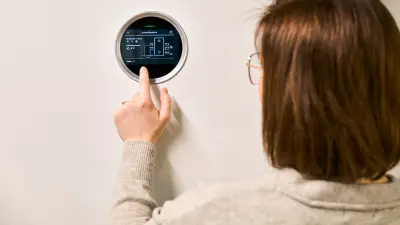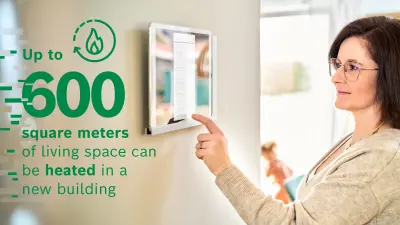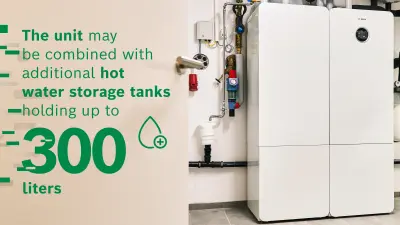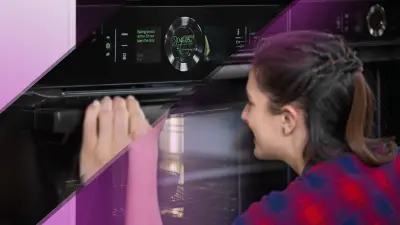How ground source heat pumps cut operating costs

Energy efficiency and sustainability are figuring more and more prominently in new buildings and in home modernization projects. With good reason: state-of-the-art ground source heat pumps such as the Compress 7800i LW from Bosch can save a lot of money over the long haul.
A self-regulating heat pump

It’s usually some household chore that sends Melanie and David Wingerter down to the basement of their sunny single-family home. Perhaps it’s time to pop in or take out another load from the washing machine. After all, the laundry basket in a household with two small children is an eternal wellspring of dirty clothes. Every now and then, the Wingerters head downstairs to rummage through their tool chest in search of the right screws and dowels. Occasionally, they reach for one of the ladders in the far corner. But they practically never have to fuss with the device standing against the basement wall — even if its shiny white housing and nifty five-inch touch control panel look quite inviting. This eye-catcher of a unit is the Compress 7800i LW ground source heat pump from Bosch.
The sound of near silence
“The best thing about this device is we practically never have to adjust anything,” says Melanie Wingerter. Her husband adds, “The heat pump does an excellent job of modulating itself. There’s nothing for us to do even when we go on vacation because it automatically turns itself down and then consumes a lot less energy.” Then there is the noise — or more accurately, the conspicuous lack of it. The unit hardly makes a sound, with nary a peep to be heard even when standing right next to it. “Sometimes it seems like the ground source heat pump has switched off,” says David Wingerter with a smile.

The best thing about this device is we practically never have to adjust anything.
A home with a cozy atmosphere
In April 2021, this family of four moved into their new home in Offenbach an der Queich, a tranquil little town surrounded by greenery in the south of the German state of Rhineland-Palatinate. It is a moment of perfect familial bliss when the sun shines into the Wingerters’ home. When the parents play with their kids Elisabeth and Karl amid the cozy confines of their children’s room, everything revolves around fairy-tale castles and unicorns. It is not just the setting and mood that feels so right; the room temperature is also perfect. And when the parents want to go out to enjoy some alone time, there are babysitters available within shouting distance. David Wingerter’s father lives next door. One aunt lives another door down and the other just across the street.

Easy app-based handling
David Wingerter manages a small electronics company, so he knows his way around technical devices. When the family began planning a new house in 2020, the Wingerters were keen to go with an energy-saving heating solution. They intended to put solar panels on their roof, so “it made sense to opt for a system that heats with electricity,” says Melanie Wingerter. They also wanted a device in the house that consumes energy sparingly and typically requires little maintenance. “When we put it all together, the decision in favor of a ground source heat pump was soon made.”
It’s all in the name: ground source heat pumps — variously called ground source and liquid to water heat pumps — are devices that extract heat from the earth. This geothermal energy can serve to heat buildings and water. It’s usually necessary to first drill a hole in the ground, for example in the home’s garden, before a liquid heat transfer medium can use the earth as a source of energy. Heat pumps with geothermal probes are remarkably energy-efficient because the temperature at a depth of ten meters remains constant throughout the year.
Zero summertime heating and electricity costs
“Using the ground as a source of heat is a good way of keeping energy needs low throughout the year,” says Marcel Schubert, Bosch product manager for ground source heat pumps. “The customer enjoys the benefits of the natural geothermal heat and extremely low operating costs.” Even in deep winter, it does not take that much energy to heat a house. And the Wingerters incur virtually no electricity costs in the summer months with the photovoltaic system doing its part to cover the family’s electricity requirements. “Our electricity costs in the summer are zero,” says Melanie Wingerter.
The pump circulates an eco-friendly water-glycol mixture to draw the heat from the earth’s interior. The ground energy is then transferred to the refrigeration circuit at the heat pump’s evaporator. A compressor applies pressure to the refrigerant so its temperature rises. At the condenser, a heat exchanger transfers the thermal energy to the heating circuit, where it heats the radiating surfaces and hot water.

Equally suitable for home modernization projects

A great advantage of this device is that it can determine how hard it has to work on its own, and regulates itself up and down as the situation requires. “Our heat pump delivers between two and eight kilowatt of power. If I don’t need a lot of heat, energy consumption stays low,” says David Wingerter. The Compress 7800i LW can cover an even wider modulation range from 2 to 16 kilowatts depending on how the unit is set up. This means a new building like the Wingerters’ is not the only use case for this ground source heat pump. “It works just as well when modernizing heating systems in suitable detached houses and small apartment buildings,” says Schubert.





